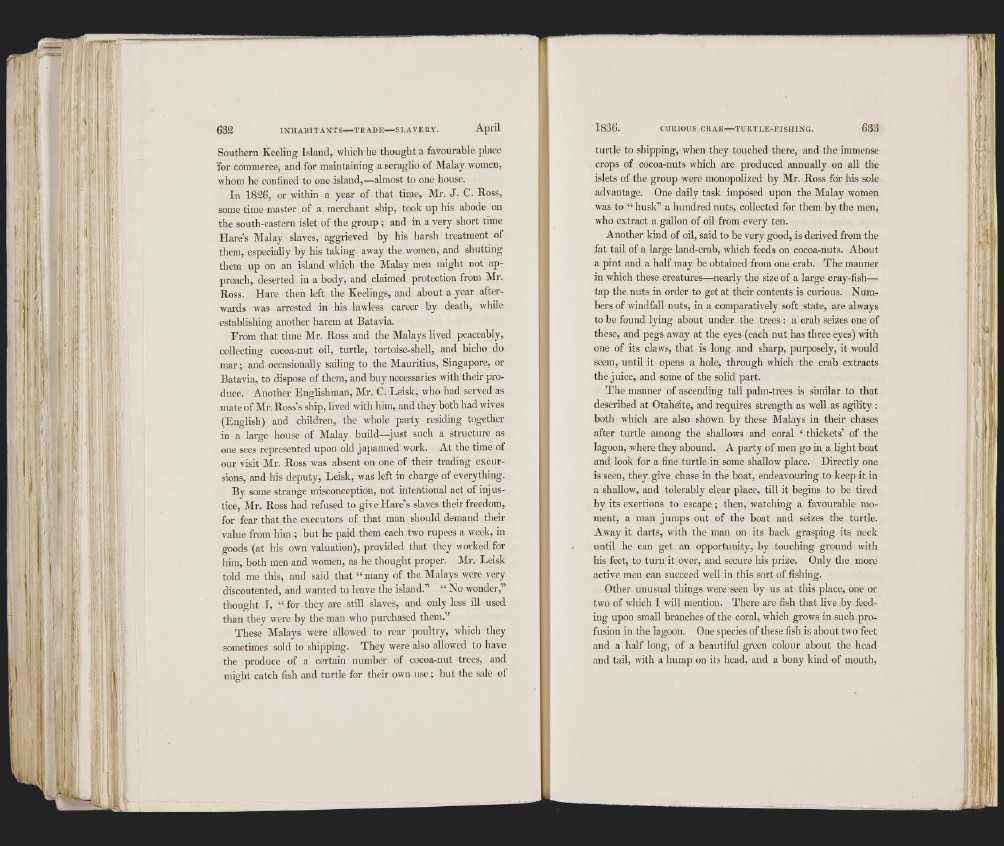
i;
ii
iC f i
632
Southern Keeling Island, which he thought a favourahle place
for connnerce, and for maintaining a seraglio of Malay women,
whom he confined to one island,—almost to one house.
In 1826, or within a year of that time, Mr. J. C. Ross,
some time master of a merchant ship, took up his ahode on
the south-eastern islet of the group ; and in a very short time
Hare’s Malay slaves, aggrieved hy his harsh treatment of
them, especially hy his taking away the women, and shutting
them up on an island which the Malay men might not approach,
deserted in a hody, and claimed protection from Mr.
Ross. Hare then left the Keelings, and ahout a year afterwards
was arrested in his lawless career hy death, while
esfahlishing another harem at Batavia.
From that time Mr. Boss and the Malays lived peaceably,
collecting cocoa-nut oil, turtle, tortoise-shell, and hicho do
mar; and occasionally sailing to the Mauritius, Singapore, or
Batavia, to dispose of them, and buy necessaries with their produce.
Another Englishman, Mr. C. Leisk, who had served as
mate of Mr. Boss’s ship, lived with him, and they both had wives
(English) and children, the whole party residing together
in a large house of Malay huild—just such a structure as
one sees represented upon old japanned work. At the time of
our visit Mr. Boss was absent on one of their trading excursions,
and his deputy, Leisk, was left in charge of everything.
By some strange misconception, not intentional act of injustice,
Mr. Boss had refused to give Hare’s slaves their freedom,
for fear that the executors of that man should demand their
value from him ; but he paid them each two rupees a week, in
goods (at his own valuation), provided that they worked for
him, both men and women, as he thought proper. Mr. Leisk
told me this, and said that “ many of the Malays were very
discontented, and wanted to leave the island.” “ No wonder,”
thought I, “ for they are still slaves, and only less ill used
than they were by the man who purchased them.”
These Malays were allowed to rear poultry, which they
sometimes sold to shipping. They were also allowed to have
the produce of a certain number of cocoa-nut trees, and
might catch fish and turtle for their own use; but the sale of
turtle to shipping, when they touched there, and the immense
crops of cocoa-nuts which are produced annually on all the
islets of the group were monopolized by Mr. Ross for his sole
advantage. One daily task imposed upon the Malay women
was to “ husk” a hundred nuts, collected for them by the men,
who extract a gallon of oil from every ten.
Another kind of oil, said to be very good, is derived from the
fat tail of a large land-crab, which feeds on cocoa-nuts. About
a pint and a half may be obtained from one crab. The manner
in which these creatures—nearly the size of a large cray-fish—
tap the nuts in order to get at their contents is curious. Numbers
of windfall nuts, in a comparatively soft state, are always
to be found lying about under the trees : a crab seizes one of
these, and pegs away at the eyes (each nut has three eyes) with
one of its claws, that is long and sharp, purposely, it would
seem, until it opens a hole, through which the crab extracts
the juice, and some of the solid part.
The manner of ascending tall palm-trees is similar to that
described at Otaheite, and requires strength as well as agility :
both which are also shown by these Malays in their chases
after turtle among the shallows and coral ‘ thickets’ of the
lagoon, where they abound. A party of men go in a light boat
and look for a fine turtle in some shallow place. Directly one
is seen, they give chase in the boat, endeavouring to keep it in
a shallow, and tolerably clear place, till it begins to be tired
by its exertions to escape; then, watching a favourahle moment,
a man jumps out of the boat and seizes the turtle.
Away it darts, with the man on its back grasping its neck
until he can get an opportunity, hy touching ground with
his feet, to turn it over, and secure his prize. Only the more
active men can succeed well in this sort of fishing.
Other unusual things were seen by us at this place, one or
two of which I will mention. There are fish that live by feeding
upon small branches of the coral, which grows in such profusion
in the lagoon. One species of these fish is about two feet
and a half long, of a beautiful green colour ahout the head
and tail, with a hump on its head, and a bony kind of mouth,
' -ft'
I' il
" i l l
'' Mi
I "ICft
J -